Financial Decision Report: Starbucks and Roast Ltd Acquisition
VerifiedAdded on 2023/01/12
|14
|4571
|98
Report
AI Summary
This report provides a comprehensive financial analysis of Starbucks' potential acquisition of Roast Ltd. It begins with an overview of the UK coffee industry, highlighting market trends and key competitors like Starbucks, Costa Coffee, and Caffe Nero. The report then delves into Roast Ltd's financial performance, assessing its profit and loss statement, balance sheet, and cash flow statement. Key financial ratios are calculated and analyzed to evaluate the company's profitability, liquidity, and capital structure. Furthermore, the report examines investment appraisal techniques and management forecasts related to a potential expansion plan in Romania. The analysis includes an assessment of funding sources and concludes with recommendations regarding the acquisition's feasibility, based on the overall financial performance and future prospects of Roast Ltd. The report also discusses the operating cash cycle and dividend policy of Roast Ltd. The analysis demonstrates that the company should expand its business.

Financial Decision Making
Paraphrase This Document
Need a fresh take? Get an instant paraphrase of this document with our AI Paraphraser
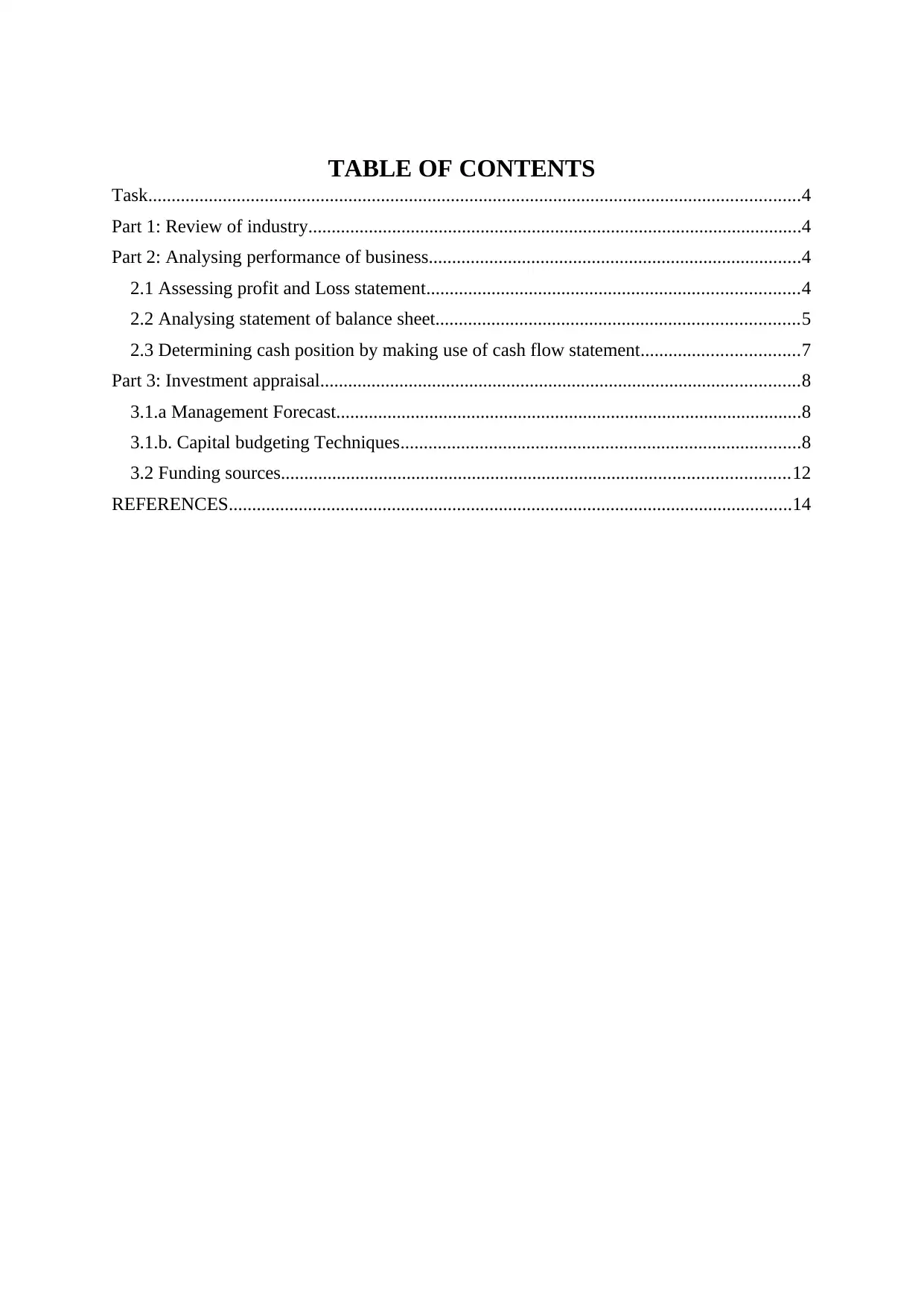
TABLE OF CONTENTS
Task............................................................................................................................................4
Part 1: Review of industry..........................................................................................................4
Part 2: Analysing performance of business................................................................................4
2.1 Assessing profit and Loss statement................................................................................4
2.2 Analysing statement of balance sheet..............................................................................5
2.3 Determining cash position by making use of cash flow statement..................................7
Part 3: Investment appraisal.......................................................................................................8
3.1.a Management Forecast....................................................................................................8
3.1.b. Capital budgeting Techniques......................................................................................8
3.2 Funding sources.............................................................................................................12
REFERENCES.........................................................................................................................14
Task............................................................................................................................................4
Part 1: Review of industry..........................................................................................................4
Part 2: Analysing performance of business................................................................................4
2.1 Assessing profit and Loss statement................................................................................4
2.2 Analysing statement of balance sheet..............................................................................5
2.3 Determining cash position by making use of cash flow statement..................................7
Part 3: Investment appraisal.......................................................................................................8
3.1.a Management Forecast....................................................................................................8
3.1.b. Capital budgeting Techniques......................................................................................8
3.2 Funding sources.............................................................................................................12
REFERENCES.........................................................................................................................14
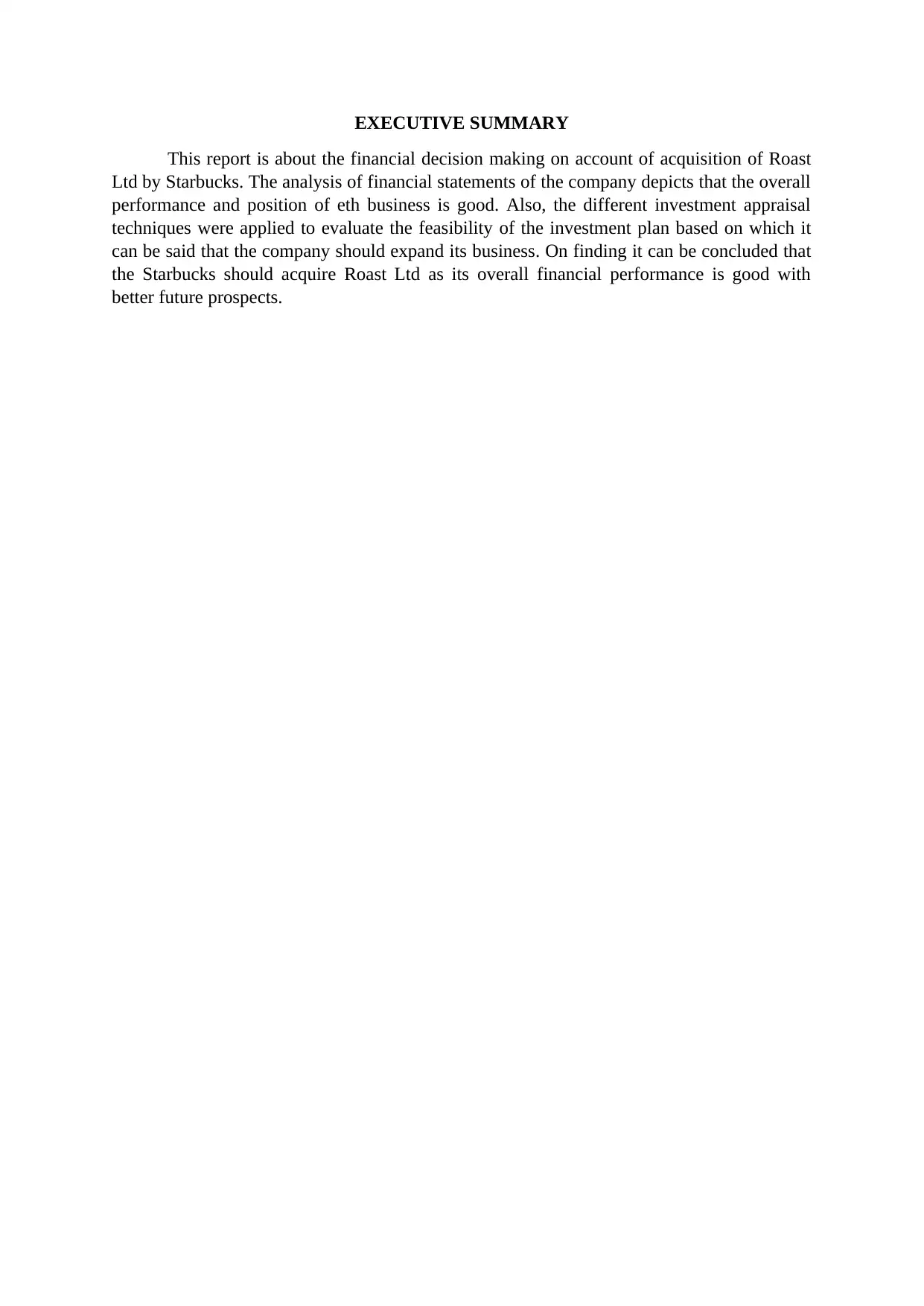
EXECUTIVE SUMMARY
This report is about the financial decision making on account of acquisition of Roast
Ltd by Starbucks. The analysis of financial statements of the company depicts that the overall
performance and position of eth business is good. Also, the different investment appraisal
techniques were applied to evaluate the feasibility of the investment plan based on which it
can be said that the company should expand its business. On finding it can be concluded that
the Starbucks should acquire Roast Ltd as its overall financial performance is good with
better future prospects.
This report is about the financial decision making on account of acquisition of Roast
Ltd by Starbucks. The analysis of financial statements of the company depicts that the overall
performance and position of eth business is good. Also, the different investment appraisal
techniques were applied to evaluate the feasibility of the investment plan based on which it
can be said that the company should expand its business. On finding it can be concluded that
the Starbucks should acquire Roast Ltd as its overall financial performance is good with
better future prospects.
⊘ This is a preview!⊘
Do you want full access?
Subscribe today to unlock all pages.

Trusted by 1+ million students worldwide

Task
Part 1: Review of industry
The coffee is the most popular drink or beverage in the UK and is very popular among
the residents of country. The coffee industry is a very growing and developing and this
adds to the growth of the overall economy of country. With the research it was outlined
that the all the coffee shops in UK are values to earn £10.1 billion across all the 25,483
outlets all over UK.
There was a rise of around 7.9 % increase in the annual sales of coffee companies in
comparison to last two decades. Also, the branded coffee shops gained a robust increase
of 8.7 % of growth in the year 2018 and the stores reached to 8149 (Coffee industry of
UK, 2018).
But the Brexit had a very negative impact on the coffee industry as when UK left EU
there was shortage of labour, increase in prices of product, and many other changes and
also change in the taste and preference of consumers.
The major competitors and big player of the coffee industry in UK includes companies
like Starbucks, Costa coffee and Caffe Nero. These are the biggest competitors of Roast
Ltd and the profitability of the company is much affected by these bigger competitors.
The companies like Starbucks has around 990 stores, Costa coffee has 2500 outlet and
Caffe Nero has around 650 stores at the global level.
Also, the aim of the coffee industry is to expand the market with approximately 10000
more stores till 2023. Also, the aim of this coffee industry is to increase the profitability
of the economy with the coffee income with around 5 % of income.
Part 2: Analysing performance of business
2.1 Assessing profit and Loss statement
As per the income statement, the revenue of Roast Ltd has increased from £2022 in
2017 to £2534 in 2018 which indicates that the sales of the company are increasing because
of its improvement in performance (Petersen, Plenborg and Kinserdal, 2017). Along with
sales, the cost of goods sold has also increased to £1990 as compared to £1505 of previous
year. Also, there has been an increase in profits because of income from other sources which
was not there last year.
Part 1: Review of industry
The coffee is the most popular drink or beverage in the UK and is very popular among
the residents of country. The coffee industry is a very growing and developing and this
adds to the growth of the overall economy of country. With the research it was outlined
that the all the coffee shops in UK are values to earn £10.1 billion across all the 25,483
outlets all over UK.
There was a rise of around 7.9 % increase in the annual sales of coffee companies in
comparison to last two decades. Also, the branded coffee shops gained a robust increase
of 8.7 % of growth in the year 2018 and the stores reached to 8149 (Coffee industry of
UK, 2018).
But the Brexit had a very negative impact on the coffee industry as when UK left EU
there was shortage of labour, increase in prices of product, and many other changes and
also change in the taste and preference of consumers.
The major competitors and big player of the coffee industry in UK includes companies
like Starbucks, Costa coffee and Caffe Nero. These are the biggest competitors of Roast
Ltd and the profitability of the company is much affected by these bigger competitors.
The companies like Starbucks has around 990 stores, Costa coffee has 2500 outlet and
Caffe Nero has around 650 stores at the global level.
Also, the aim of the coffee industry is to expand the market with approximately 10000
more stores till 2023. Also, the aim of this coffee industry is to increase the profitability
of the economy with the coffee income with around 5 % of income.
Part 2: Analysing performance of business
2.1 Assessing profit and Loss statement
As per the income statement, the revenue of Roast Ltd has increased from £2022 in
2017 to £2534 in 2018 which indicates that the sales of the company are increasing because
of its improvement in performance (Petersen, Plenborg and Kinserdal, 2017). Along with
sales, the cost of goods sold has also increased to £1990 as compared to £1505 of previous
year. Also, there has been an increase in profits because of income from other sources which
was not there last year.
Paraphrase This Document
Need a fresh take? Get an instant paraphrase of this document with our AI Paraphraser
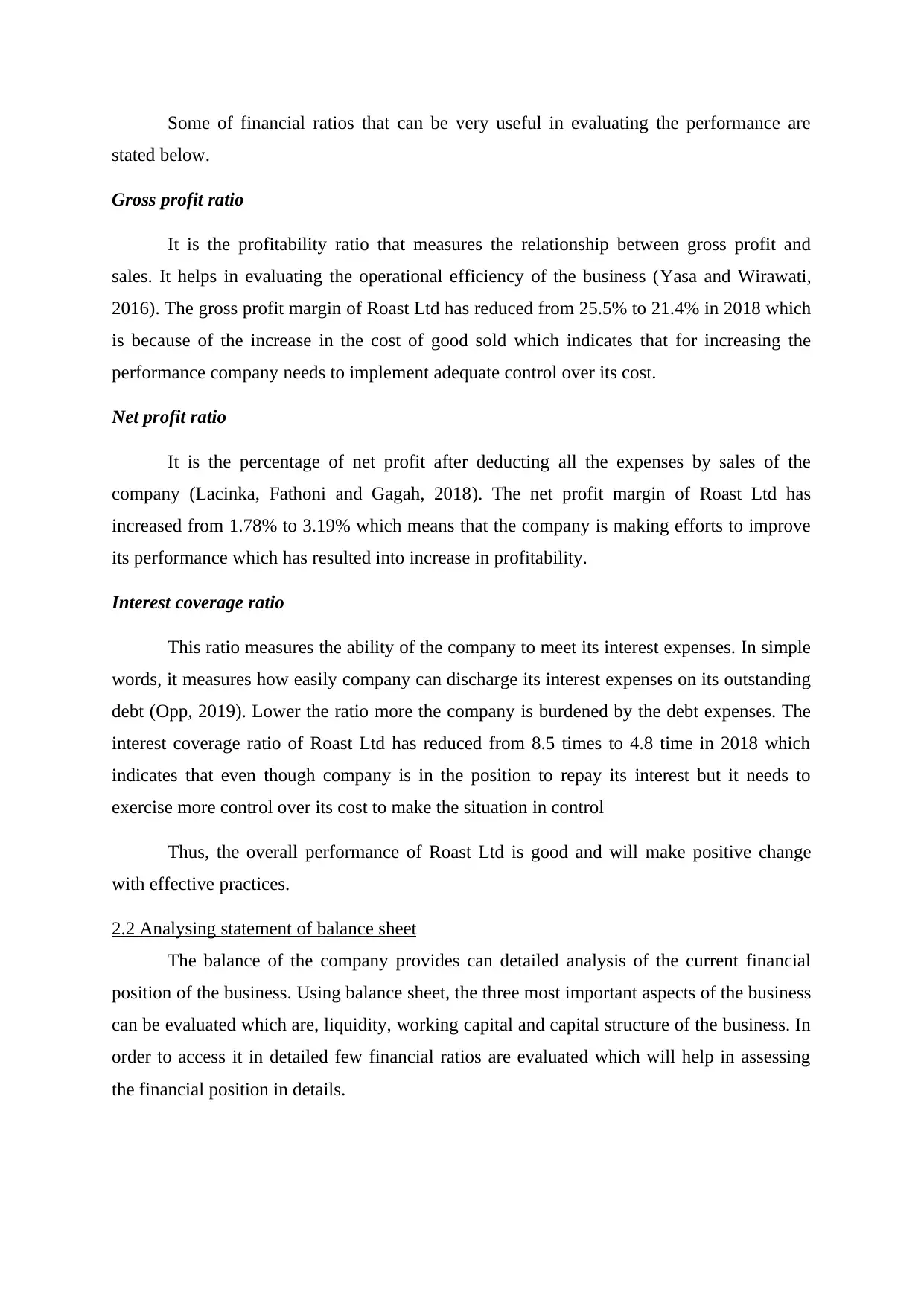
Some of financial ratios that can be very useful in evaluating the performance are
stated below.
Gross profit ratio
It is the profitability ratio that measures the relationship between gross profit and
sales. It helps in evaluating the operational efficiency of the business (Yasa and Wirawati,
2016). The gross profit margin of Roast Ltd has reduced from 25.5% to 21.4% in 2018 which
is because of the increase in the cost of good sold which indicates that for increasing the
performance company needs to implement adequate control over its cost.
Net profit ratio
It is the percentage of net profit after deducting all the expenses by sales of the
company (Lacinka, Fathoni and Gagah, 2018). The net profit margin of Roast Ltd has
increased from 1.78% to 3.19% which means that the company is making efforts to improve
its performance which has resulted into increase in profitability.
Interest coverage ratio
This ratio measures the ability of the company to meet its interest expenses. In simple
words, it measures how easily company can discharge its interest expenses on its outstanding
debt (Opp, 2019). Lower the ratio more the company is burdened by the debt expenses. The
interest coverage ratio of Roast Ltd has reduced from 8.5 times to 4.8 time in 2018 which
indicates that even though company is in the position to repay its interest but it needs to
exercise more control over its cost to make the situation in control
Thus, the overall performance of Roast Ltd is good and will make positive change
with effective practices.
2.2 Analysing statement of balance sheet
The balance of the company provides can detailed analysis of the current financial
position of the business. Using balance sheet, the three most important aspects of the business
can be evaluated which are, liquidity, working capital and capital structure of the business. In
order to access it in detailed few financial ratios are evaluated which will help in assessing
the financial position in details.
stated below.
Gross profit ratio
It is the profitability ratio that measures the relationship between gross profit and
sales. It helps in evaluating the operational efficiency of the business (Yasa and Wirawati,
2016). The gross profit margin of Roast Ltd has reduced from 25.5% to 21.4% in 2018 which
is because of the increase in the cost of good sold which indicates that for increasing the
performance company needs to implement adequate control over its cost.
Net profit ratio
It is the percentage of net profit after deducting all the expenses by sales of the
company (Lacinka, Fathoni and Gagah, 2018). The net profit margin of Roast Ltd has
increased from 1.78% to 3.19% which means that the company is making efforts to improve
its performance which has resulted into increase in profitability.
Interest coverage ratio
This ratio measures the ability of the company to meet its interest expenses. In simple
words, it measures how easily company can discharge its interest expenses on its outstanding
debt (Opp, 2019). Lower the ratio more the company is burdened by the debt expenses. The
interest coverage ratio of Roast Ltd has reduced from 8.5 times to 4.8 time in 2018 which
indicates that even though company is in the position to repay its interest but it needs to
exercise more control over its cost to make the situation in control
Thus, the overall performance of Roast Ltd is good and will make positive change
with effective practices.
2.2 Analysing statement of balance sheet
The balance of the company provides can detailed analysis of the current financial
position of the business. Using balance sheet, the three most important aspects of the business
can be evaluated which are, liquidity, working capital and capital structure of the business. In
order to access it in detailed few financial ratios are evaluated which will help in assessing
the financial position in details.
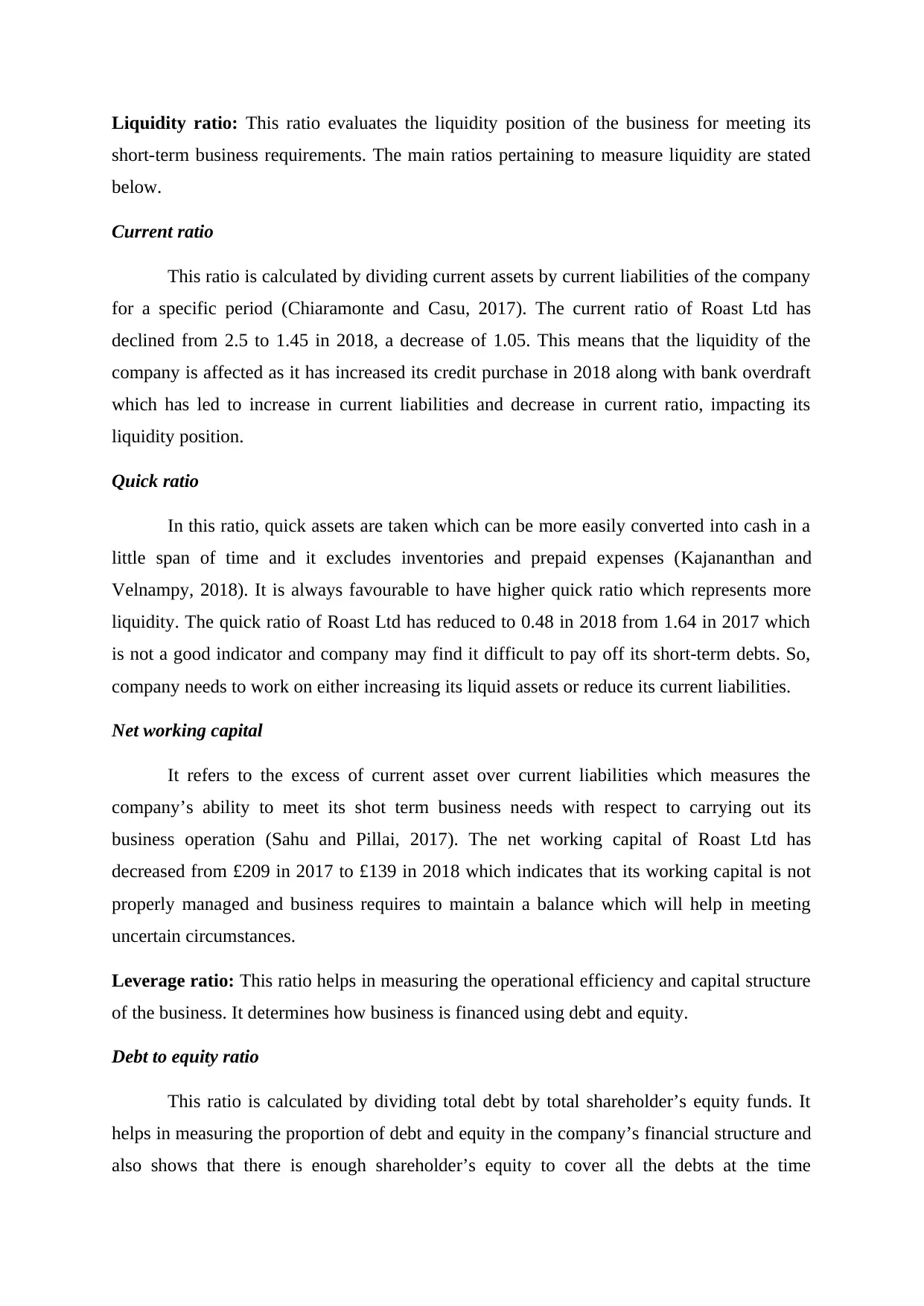
Liquidity ratio: This ratio evaluates the liquidity position of the business for meeting its
short-term business requirements. The main ratios pertaining to measure liquidity are stated
below.
Current ratio
This ratio is calculated by dividing current assets by current liabilities of the company
for a specific period (Chiaramonte and Casu, 2017). The current ratio of Roast Ltd has
declined from 2.5 to 1.45 in 2018, a decrease of 1.05. This means that the liquidity of the
company is affected as it has increased its credit purchase in 2018 along with bank overdraft
which has led to increase in current liabilities and decrease in current ratio, impacting its
liquidity position.
Quick ratio
In this ratio, quick assets are taken which can be more easily converted into cash in a
little span of time and it excludes inventories and prepaid expenses (Kajananthan and
Velnampy, 2018). It is always favourable to have higher quick ratio which represents more
liquidity. The quick ratio of Roast Ltd has reduced to 0.48 in 2018 from 1.64 in 2017 which
is not a good indicator and company may find it difficult to pay off its short-term debts. So,
company needs to work on either increasing its liquid assets or reduce its current liabilities.
Net working capital
It refers to the excess of current asset over current liabilities which measures the
company’s ability to meet its shot term business needs with respect to carrying out its
business operation (Sahu and Pillai, 2017). The net working capital of Roast Ltd has
decreased from £209 in 2017 to £139 in 2018 which indicates that its working capital is not
properly managed and business requires to maintain a balance which will help in meeting
uncertain circumstances.
Leverage ratio: This ratio helps in measuring the operational efficiency and capital structure
of the business. It determines how business is financed using debt and equity.
Debt to equity ratio
This ratio is calculated by dividing total debt by total shareholder’s equity funds. It
helps in measuring the proportion of debt and equity in the company’s financial structure and
also shows that there is enough shareholder’s equity to cover all the debts at the time
short-term business requirements. The main ratios pertaining to measure liquidity are stated
below.
Current ratio
This ratio is calculated by dividing current assets by current liabilities of the company
for a specific period (Chiaramonte and Casu, 2017). The current ratio of Roast Ltd has
declined from 2.5 to 1.45 in 2018, a decrease of 1.05. This means that the liquidity of the
company is affected as it has increased its credit purchase in 2018 along with bank overdraft
which has led to increase in current liabilities and decrease in current ratio, impacting its
liquidity position.
Quick ratio
In this ratio, quick assets are taken which can be more easily converted into cash in a
little span of time and it excludes inventories and prepaid expenses (Kajananthan and
Velnampy, 2018). It is always favourable to have higher quick ratio which represents more
liquidity. The quick ratio of Roast Ltd has reduced to 0.48 in 2018 from 1.64 in 2017 which
is not a good indicator and company may find it difficult to pay off its short-term debts. So,
company needs to work on either increasing its liquid assets or reduce its current liabilities.
Net working capital
It refers to the excess of current asset over current liabilities which measures the
company’s ability to meet its shot term business needs with respect to carrying out its
business operation (Sahu and Pillai, 2017). The net working capital of Roast Ltd has
decreased from £209 in 2017 to £139 in 2018 which indicates that its working capital is not
properly managed and business requires to maintain a balance which will help in meeting
uncertain circumstances.
Leverage ratio: This ratio helps in measuring the operational efficiency and capital structure
of the business. It determines how business is financed using debt and equity.
Debt to equity ratio
This ratio is calculated by dividing total debt by total shareholder’s equity funds. It
helps in measuring the proportion of debt and equity in the company’s financial structure and
also shows that there is enough shareholder’s equity to cover all the debts at the time
⊘ This is a preview!⊘
Do you want full access?
Subscribe today to unlock all pages.

Trusted by 1+ million students worldwide
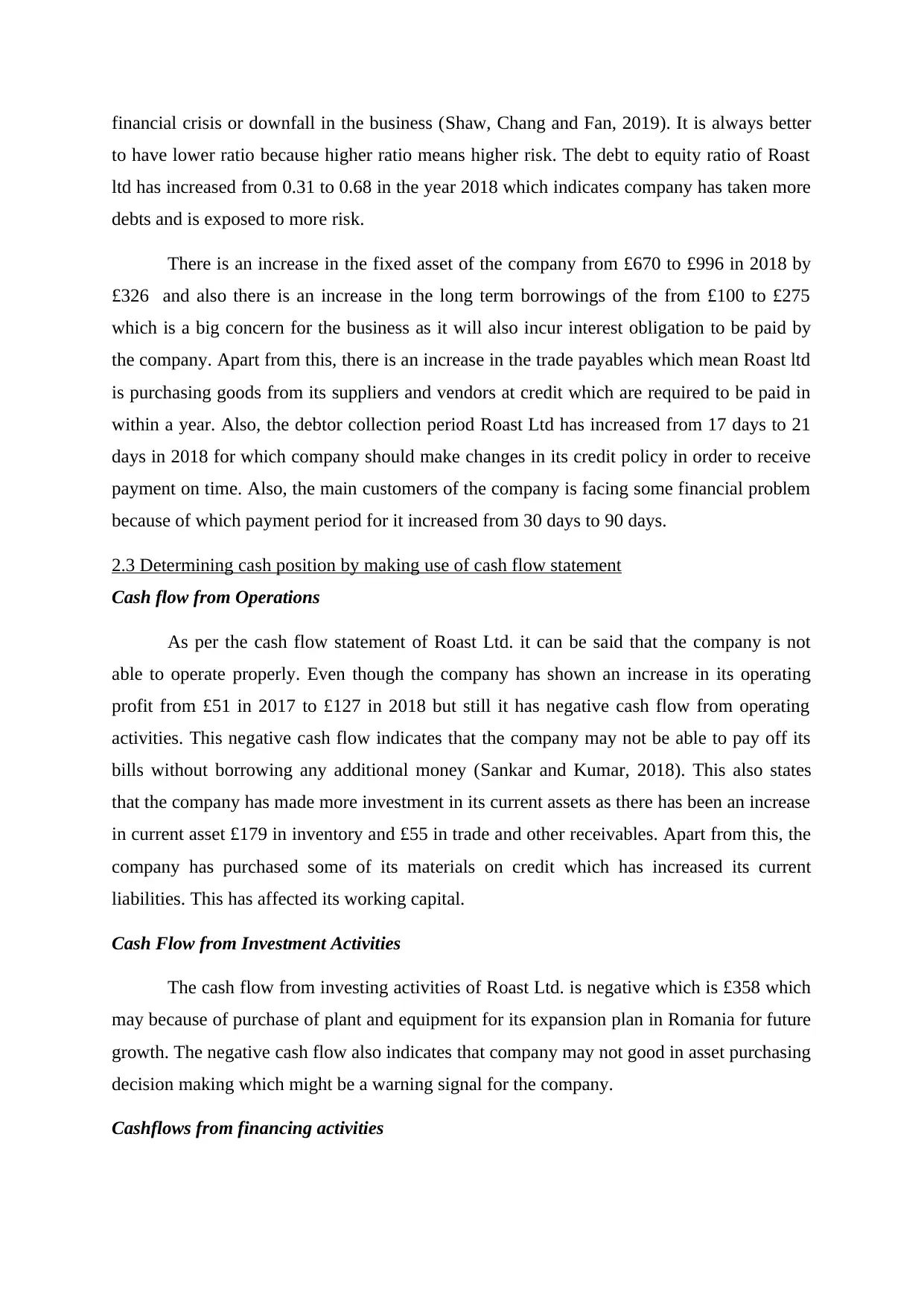
financial crisis or downfall in the business (Shaw, Chang and Fan, 2019). It is always better
to have lower ratio because higher ratio means higher risk. The debt to equity ratio of Roast
ltd has increased from 0.31 to 0.68 in the year 2018 which indicates company has taken more
debts and is exposed to more risk.
There is an increase in the fixed asset of the company from £670 to £996 in 2018 by
£326 and also there is an increase in the long term borrowings of the from £100 to £275
which is a big concern for the business as it will also incur interest obligation to be paid by
the company. Apart from this, there is an increase in the trade payables which mean Roast ltd
is purchasing goods from its suppliers and vendors at credit which are required to be paid in
within a year. Also, the debtor collection period Roast Ltd has increased from 17 days to 21
days in 2018 for which company should make changes in its credit policy in order to receive
payment on time. Also, the main customers of the company is facing some financial problem
because of which payment period for it increased from 30 days to 90 days.
2.3 Determining cash position by making use of cash flow statement
Cash flow from Operations
As per the cash flow statement of Roast Ltd. it can be said that the company is not
able to operate properly. Even though the company has shown an increase in its operating
profit from £51 in 2017 to £127 in 2018 but still it has negative cash flow from operating
activities. This negative cash flow indicates that the company may not be able to pay off its
bills without borrowing any additional money (Sankar and Kumar, 2018). This also states
that the company has made more investment in its current assets as there has been an increase
in current asset £179 in inventory and £55 in trade and other receivables. Apart from this, the
company has purchased some of its materials on credit which has increased its current
liabilities. This has affected its working capital.
Cash Flow from Investment Activities
The cash flow from investing activities of Roast Ltd. is negative which is £358 which
may because of purchase of plant and equipment for its expansion plan in Romania for future
growth. The negative cash flow also indicates that company may not good in asset purchasing
decision making which might be a warning signal for the company.
Cashflows from financing activities
to have lower ratio because higher ratio means higher risk. The debt to equity ratio of Roast
ltd has increased from 0.31 to 0.68 in the year 2018 which indicates company has taken more
debts and is exposed to more risk.
There is an increase in the fixed asset of the company from £670 to £996 in 2018 by
£326 and also there is an increase in the long term borrowings of the from £100 to £275
which is a big concern for the business as it will also incur interest obligation to be paid by
the company. Apart from this, there is an increase in the trade payables which mean Roast ltd
is purchasing goods from its suppliers and vendors at credit which are required to be paid in
within a year. Also, the debtor collection period Roast Ltd has increased from 17 days to 21
days in 2018 for which company should make changes in its credit policy in order to receive
payment on time. Also, the main customers of the company is facing some financial problem
because of which payment period for it increased from 30 days to 90 days.
2.3 Determining cash position by making use of cash flow statement
Cash flow from Operations
As per the cash flow statement of Roast Ltd. it can be said that the company is not
able to operate properly. Even though the company has shown an increase in its operating
profit from £51 in 2017 to £127 in 2018 but still it has negative cash flow from operating
activities. This negative cash flow indicates that the company may not be able to pay off its
bills without borrowing any additional money (Sankar and Kumar, 2018). This also states
that the company has made more investment in its current assets as there has been an increase
in current asset £179 in inventory and £55 in trade and other receivables. Apart from this, the
company has purchased some of its materials on credit which has increased its current
liabilities. This has affected its working capital.
Cash Flow from Investment Activities
The cash flow from investing activities of Roast Ltd. is negative which is £358 which
may because of purchase of plant and equipment for its expansion plan in Romania for future
growth. The negative cash flow also indicates that company may not good in asset purchasing
decision making which might be a warning signal for the company.
Cashflows from financing activities
Paraphrase This Document
Need a fresh take? Get an instant paraphrase of this document with our AI Paraphraser
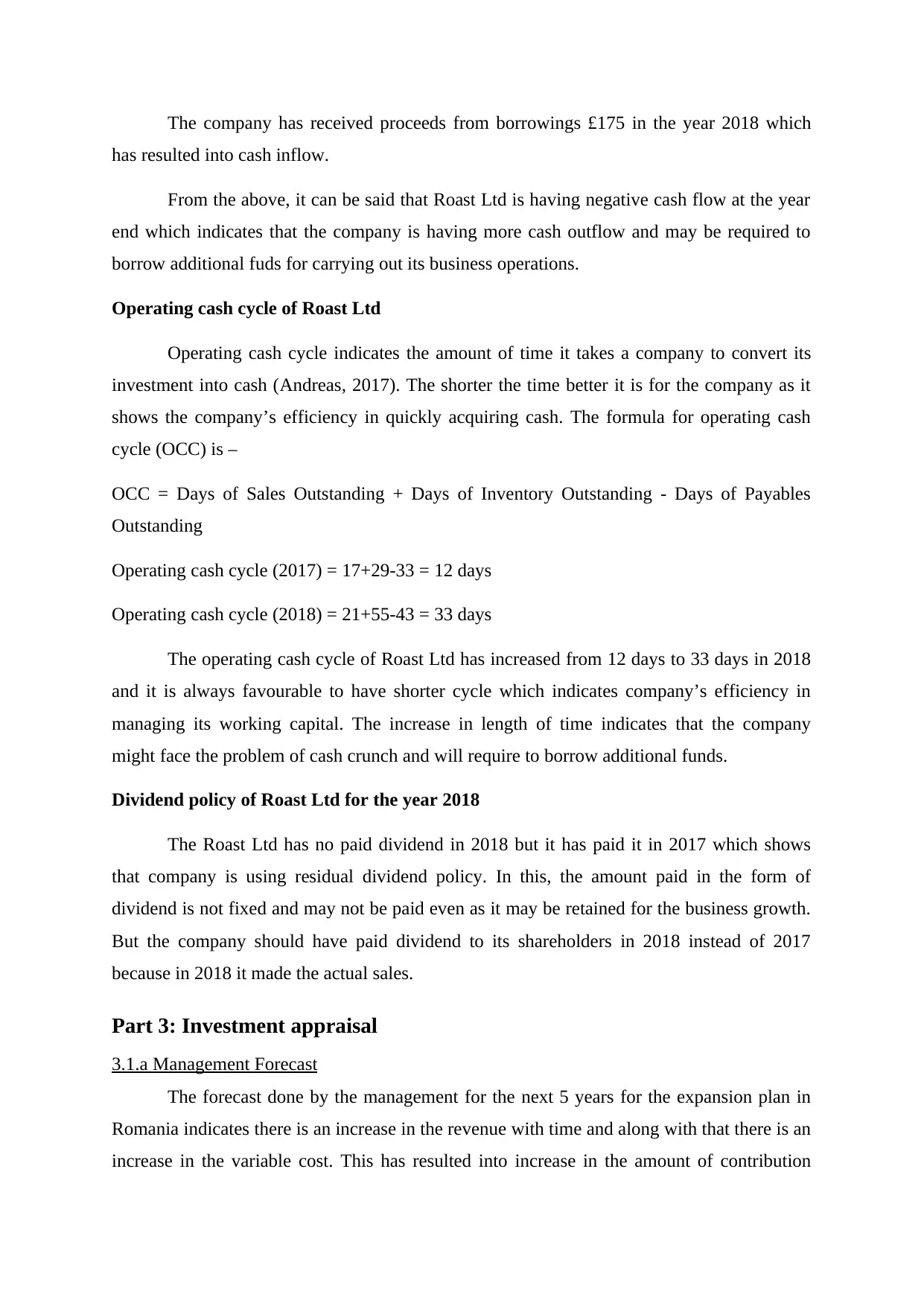
The company has received proceeds from borrowings £175 in the year 2018 which
has resulted into cash inflow.
From the above, it can be said that Roast Ltd is having negative cash flow at the year
end which indicates that the company is having more cash outflow and may be required to
borrow additional fuds for carrying out its business operations.
Operating cash cycle of Roast Ltd
Operating cash cycle indicates the amount of time it takes a company to convert its
investment into cash (Andreas, 2017). The shorter the time better it is for the company as it
shows the company’s efficiency in quickly acquiring cash. The formula for operating cash
cycle (OCC) is –
OCC = Days of Sales Outstanding + Days of Inventory Outstanding - Days of Payables
Outstanding
Operating cash cycle (2017) = 17+29-33 = 12 days
Operating cash cycle (2018) = 21+55-43 = 33 days
The operating cash cycle of Roast Ltd has increased from 12 days to 33 days in 2018
and it is always favourable to have shorter cycle which indicates company’s efficiency in
managing its working capital. The increase in length of time indicates that the company
might face the problem of cash crunch and will require to borrow additional funds.
Dividend policy of Roast Ltd for the year 2018
The Roast Ltd has no paid dividend in 2018 but it has paid it in 2017 which shows
that company is using residual dividend policy. In this, the amount paid in the form of
dividend is not fixed and may not be paid even as it may be retained for the business growth.
But the company should have paid dividend to its shareholders in 2018 instead of 2017
because in 2018 it made the actual sales.
Part 3: Investment appraisal
3.1.a Management Forecast
The forecast done by the management for the next 5 years for the expansion plan in
Romania indicates there is an increase in the revenue with time and along with that there is an
increase in the variable cost. This has resulted into increase in the amount of contribution
has resulted into cash inflow.
From the above, it can be said that Roast Ltd is having negative cash flow at the year
end which indicates that the company is having more cash outflow and may be required to
borrow additional fuds for carrying out its business operations.
Operating cash cycle of Roast Ltd
Operating cash cycle indicates the amount of time it takes a company to convert its
investment into cash (Andreas, 2017). The shorter the time better it is for the company as it
shows the company’s efficiency in quickly acquiring cash. The formula for operating cash
cycle (OCC) is –
OCC = Days of Sales Outstanding + Days of Inventory Outstanding - Days of Payables
Outstanding
Operating cash cycle (2017) = 17+29-33 = 12 days
Operating cash cycle (2018) = 21+55-43 = 33 days
The operating cash cycle of Roast Ltd has increased from 12 days to 33 days in 2018
and it is always favourable to have shorter cycle which indicates company’s efficiency in
managing its working capital. The increase in length of time indicates that the company
might face the problem of cash crunch and will require to borrow additional funds.
Dividend policy of Roast Ltd for the year 2018
The Roast Ltd has no paid dividend in 2018 but it has paid it in 2017 which shows
that company is using residual dividend policy. In this, the amount paid in the form of
dividend is not fixed and may not be paid even as it may be retained for the business growth.
But the company should have paid dividend to its shareholders in 2018 instead of 2017
because in 2018 it made the actual sales.
Part 3: Investment appraisal
3.1.a Management Forecast
The forecast done by the management for the next 5 years for the expansion plan in
Romania indicates there is an increase in the revenue with time and along with that there is an
increase in the variable cost. This has resulted into increase in the amount of contribution
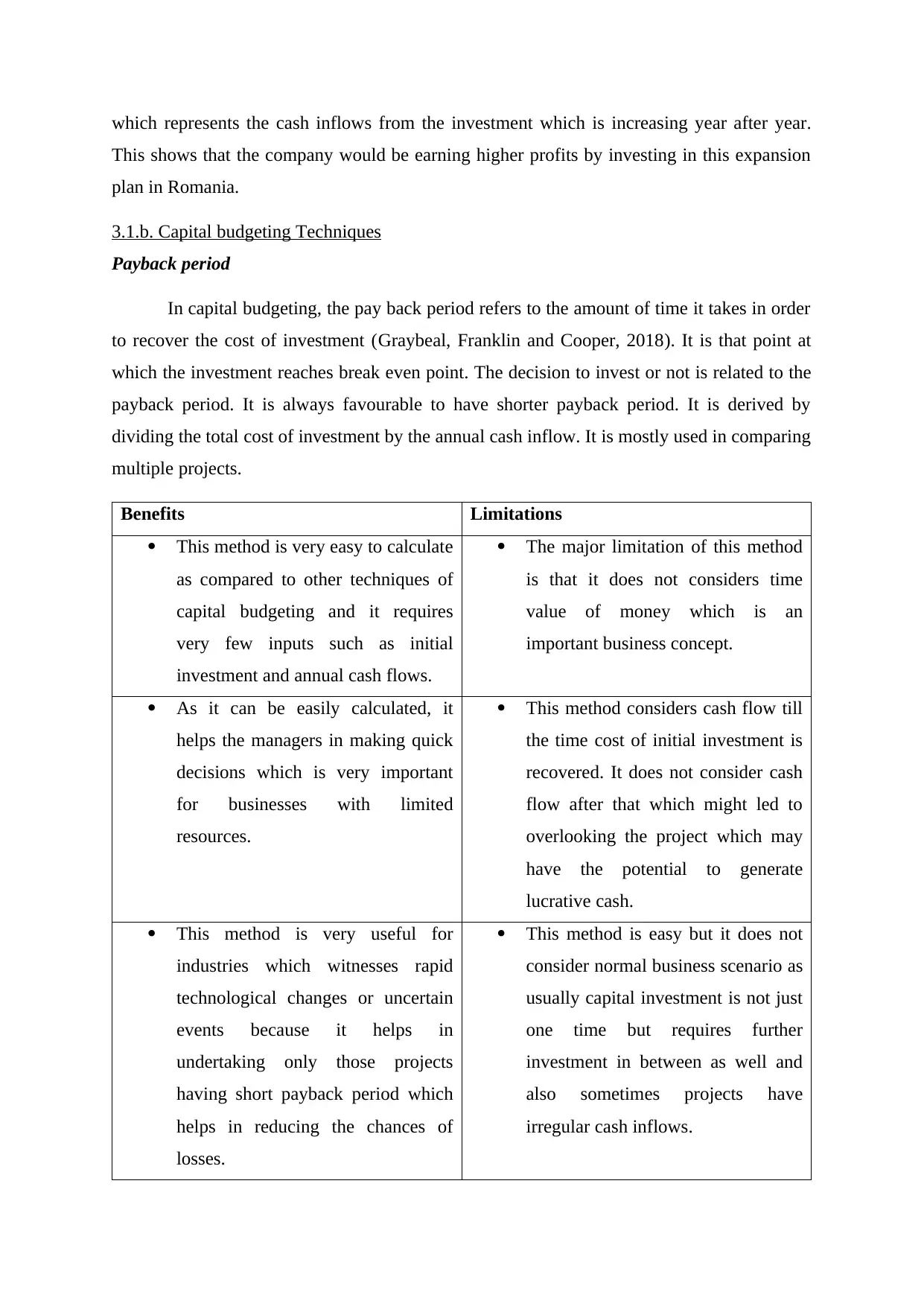
which represents the cash inflows from the investment which is increasing year after year.
This shows that the company would be earning higher profits by investing in this expansion
plan in Romania.
3.1.b. Capital budgeting Techniques
Payback period
In capital budgeting, the pay back period refers to the amount of time it takes in order
to recover the cost of investment (Graybeal, Franklin and Cooper, 2018). It is that point at
which the investment reaches break even point. The decision to invest or not is related to the
payback period. It is always favourable to have shorter payback period. It is derived by
dividing the total cost of investment by the annual cash inflow. It is mostly used in comparing
multiple projects.
Benefits Limitations
This method is very easy to calculate
as compared to other techniques of
capital budgeting and it requires
very few inputs such as initial
investment and annual cash flows.
The major limitation of this method
is that it does not considers time
value of money which is an
important business concept.
As it can be easily calculated, it
helps the managers in making quick
decisions which is very important
for businesses with limited
resources.
This method considers cash flow till
the time cost of initial investment is
recovered. It does not consider cash
flow after that which might led to
overlooking the project which may
have the potential to generate
lucrative cash.
This method is very useful for
industries which witnesses rapid
technological changes or uncertain
events because it helps in
undertaking only those projects
having short payback period which
helps in reducing the chances of
losses.
This method is easy but it does not
consider normal business scenario as
usually capital investment is not just
one time but requires further
investment in between as well and
also sometimes projects have
irregular cash inflows.
This shows that the company would be earning higher profits by investing in this expansion
plan in Romania.
3.1.b. Capital budgeting Techniques
Payback period
In capital budgeting, the pay back period refers to the amount of time it takes in order
to recover the cost of investment (Graybeal, Franklin and Cooper, 2018). It is that point at
which the investment reaches break even point. The decision to invest or not is related to the
payback period. It is always favourable to have shorter payback period. It is derived by
dividing the total cost of investment by the annual cash inflow. It is mostly used in comparing
multiple projects.
Benefits Limitations
This method is very easy to calculate
as compared to other techniques of
capital budgeting and it requires
very few inputs such as initial
investment and annual cash flows.
The major limitation of this method
is that it does not considers time
value of money which is an
important business concept.
As it can be easily calculated, it
helps the managers in making quick
decisions which is very important
for businesses with limited
resources.
This method considers cash flow till
the time cost of initial investment is
recovered. It does not consider cash
flow after that which might led to
overlooking the project which may
have the potential to generate
lucrative cash.
This method is very useful for
industries which witnesses rapid
technological changes or uncertain
events because it helps in
undertaking only those projects
having short payback period which
helps in reducing the chances of
losses.
This method is easy but it does not
consider normal business scenario as
usually capital investment is not just
one time but requires further
investment in between as well and
also sometimes projects have
irregular cash inflows.
⊘ This is a preview!⊘
Do you want full access?
Subscribe today to unlock all pages.

Trusted by 1+ million students worldwide
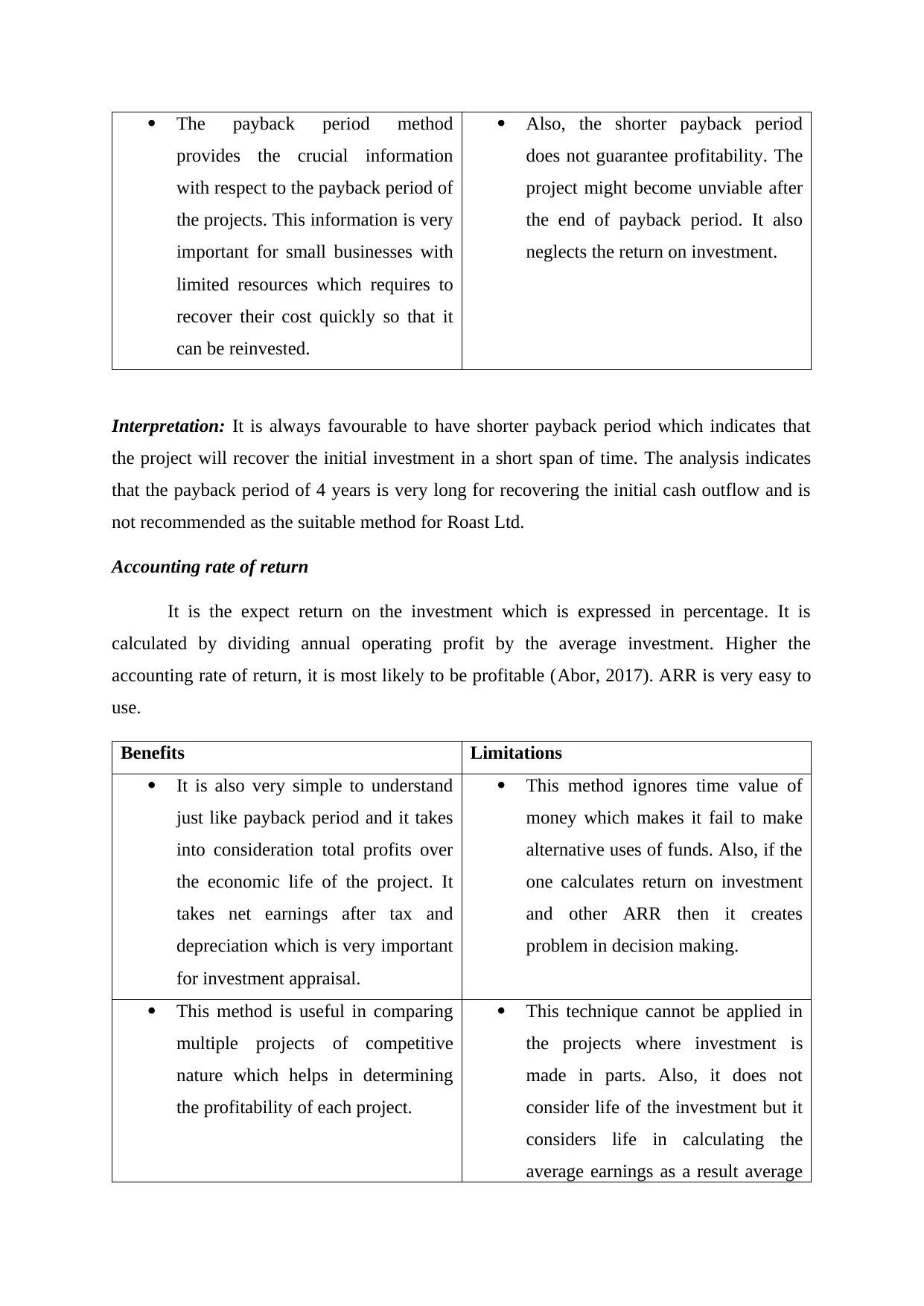
The payback period method
provides the crucial information
with respect to the payback period of
the projects. This information is very
important for small businesses with
limited resources which requires to
recover their cost quickly so that it
can be reinvested.
Also, the shorter payback period
does not guarantee profitability. The
project might become unviable after
the end of payback period. It also
neglects the return on investment.
Interpretation: It is always favourable to have shorter payback period which indicates that
the project will recover the initial investment in a short span of time. The analysis indicates
that the payback period of 4 years is very long for recovering the initial cash outflow and is
not recommended as the suitable method for Roast Ltd.
Accounting rate of return
It is the expect return on the investment which is expressed in percentage. It is
calculated by dividing annual operating profit by the average investment. Higher the
accounting rate of return, it is most likely to be profitable (Abor, 2017). ARR is very easy to
use.
Benefits Limitations
It is also very simple to understand
just like payback period and it takes
into consideration total profits over
the economic life of the project. It
takes net earnings after tax and
depreciation which is very important
for investment appraisal.
This method ignores time value of
money which makes it fail to make
alternative uses of funds. Also, if the
one calculates return on investment
and other ARR then it creates
problem in decision making.
This method is useful in comparing
multiple projects of competitive
nature which helps in determining
the profitability of each project.
This technique cannot be applied in
the projects where investment is
made in parts. Also, it does not
consider life of the investment but it
considers life in calculating the
average earnings as a result average
provides the crucial information
with respect to the payback period of
the projects. This information is very
important for small businesses with
limited resources which requires to
recover their cost quickly so that it
can be reinvested.
Also, the shorter payback period
does not guarantee profitability. The
project might become unviable after
the end of payback period. It also
neglects the return on investment.
Interpretation: It is always favourable to have shorter payback period which indicates that
the project will recover the initial investment in a short span of time. The analysis indicates
that the payback period of 4 years is very long for recovering the initial cash outflow and is
not recommended as the suitable method for Roast Ltd.
Accounting rate of return
It is the expect return on the investment which is expressed in percentage. It is
calculated by dividing annual operating profit by the average investment. Higher the
accounting rate of return, it is most likely to be profitable (Abor, 2017). ARR is very easy to
use.
Benefits Limitations
It is also very simple to understand
just like payback period and it takes
into consideration total profits over
the economic life of the project. It
takes net earnings after tax and
depreciation which is very important
for investment appraisal.
This method ignores time value of
money which makes it fail to make
alternative uses of funds. Also, if the
one calculates return on investment
and other ARR then it creates
problem in decision making.
This method is useful in comparing
multiple projects of competitive
nature which helps in determining
the profitability of each project.
This technique cannot be applied in
the projects where investment is
made in parts. Also, it does not
consider life of the investment but it
considers life in calculating the
average earnings as a result average
Paraphrase This Document
Need a fresh take? Get an instant paraphrase of this document with our AI Paraphraser
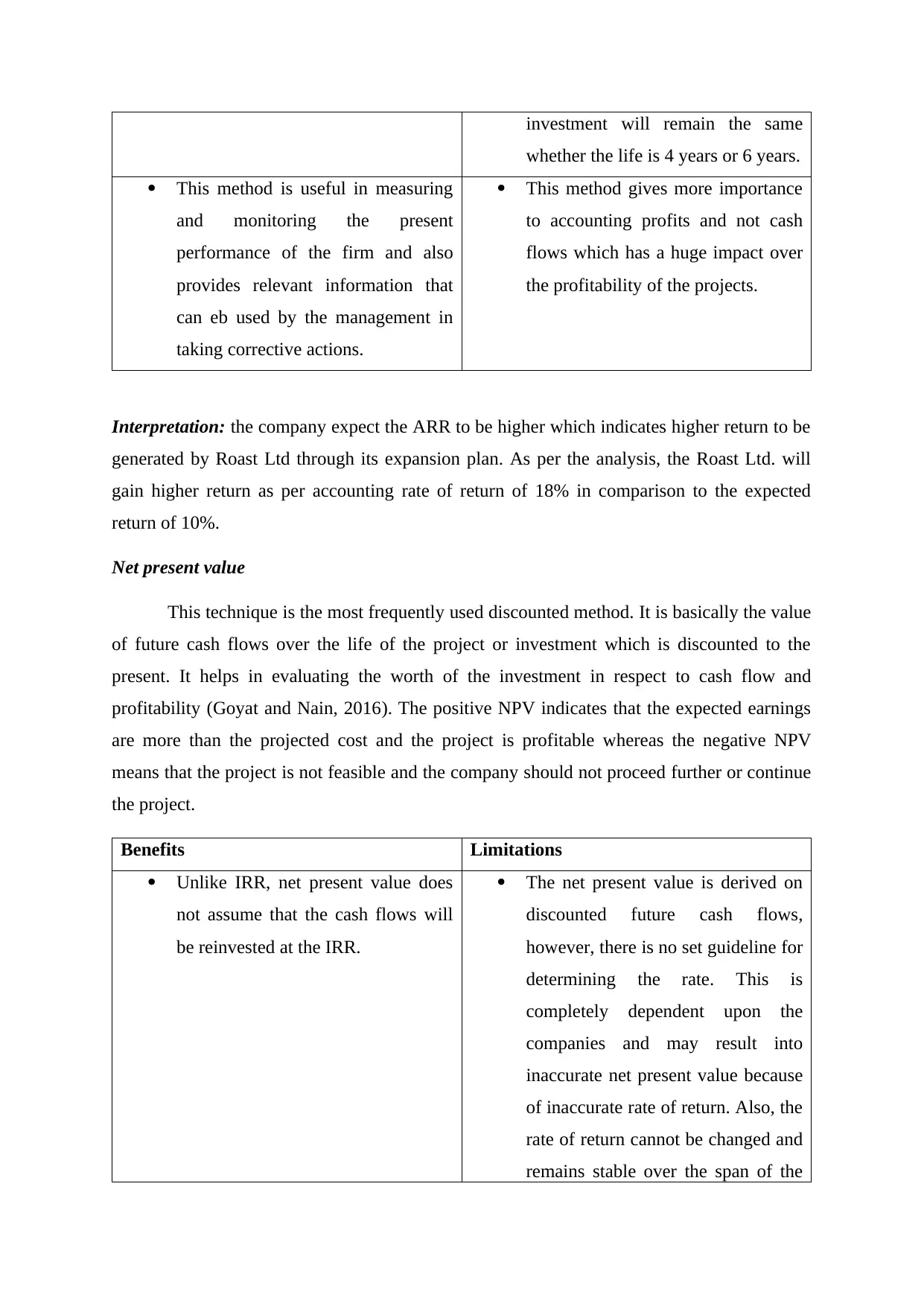
investment will remain the same
whether the life is 4 years or 6 years.
This method is useful in measuring
and monitoring the present
performance of the firm and also
provides relevant information that
can eb used by the management in
taking corrective actions.
This method gives more importance
to accounting profits and not cash
flows which has a huge impact over
the profitability of the projects.
Interpretation: the company expect the ARR to be higher which indicates higher return to be
generated by Roast Ltd through its expansion plan. As per the analysis, the Roast Ltd. will
gain higher return as per accounting rate of return of 18% in comparison to the expected
return of 10%.
Net present value
This technique is the most frequently used discounted method. It is basically the value
of future cash flows over the life of the project or investment which is discounted to the
present. It helps in evaluating the worth of the investment in respect to cash flow and
profitability (Goyat and Nain, 2016). The positive NPV indicates that the expected earnings
are more than the projected cost and the project is profitable whereas the negative NPV
means that the project is not feasible and the company should not proceed further or continue
the project.
Benefits Limitations
Unlike IRR, net present value does
not assume that the cash flows will
be reinvested at the IRR.
The net present value is derived on
discounted future cash flows,
however, there is no set guideline for
determining the rate. This is
completely dependent upon the
companies and may result into
inaccurate net present value because
of inaccurate rate of return. Also, the
rate of return cannot be changed and
remains stable over the span of the
whether the life is 4 years or 6 years.
This method is useful in measuring
and monitoring the present
performance of the firm and also
provides relevant information that
can eb used by the management in
taking corrective actions.
This method gives more importance
to accounting profits and not cash
flows which has a huge impact over
the profitability of the projects.
Interpretation: the company expect the ARR to be higher which indicates higher return to be
generated by Roast Ltd through its expansion plan. As per the analysis, the Roast Ltd. will
gain higher return as per accounting rate of return of 18% in comparison to the expected
return of 10%.
Net present value
This technique is the most frequently used discounted method. It is basically the value
of future cash flows over the life of the project or investment which is discounted to the
present. It helps in evaluating the worth of the investment in respect to cash flow and
profitability (Goyat and Nain, 2016). The positive NPV indicates that the expected earnings
are more than the projected cost and the project is profitable whereas the negative NPV
means that the project is not feasible and the company should not proceed further or continue
the project.
Benefits Limitations
Unlike IRR, net present value does
not assume that the cash flows will
be reinvested at the IRR.
The net present value is derived on
discounted future cash flows,
however, there is no set guideline for
determining the rate. This is
completely dependent upon the
companies and may result into
inaccurate net present value because
of inaccurate rate of return. Also, the
rate of return cannot be changed and
remains stable over the span of the
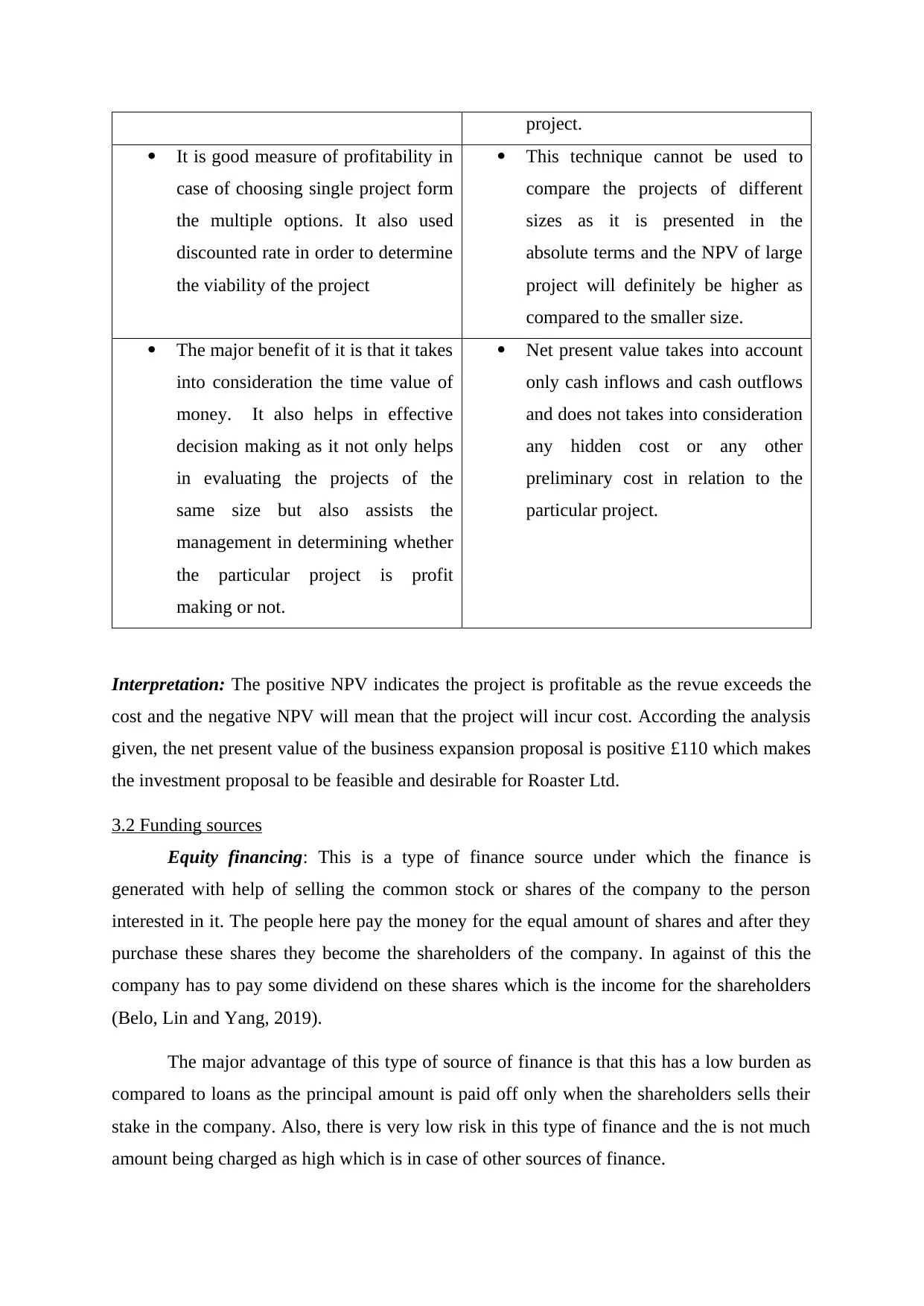
project.
It is good measure of profitability in
case of choosing single project form
the multiple options. It also used
discounted rate in order to determine
the viability of the project
This technique cannot be used to
compare the projects of different
sizes as it is presented in the
absolute terms and the NPV of large
project will definitely be higher as
compared to the smaller size.
The major benefit of it is that it takes
into consideration the time value of
money. It also helps in effective
decision making as it not only helps
in evaluating the projects of the
same size but also assists the
management in determining whether
the particular project is profit
making or not.
Net present value takes into account
only cash inflows and cash outflows
and does not takes into consideration
any hidden cost or any other
preliminary cost in relation to the
particular project.
Interpretation: The positive NPV indicates the project is profitable as the revue exceeds the
cost and the negative NPV will mean that the project will incur cost. According the analysis
given, the net present value of the business expansion proposal is positive £110 which makes
the investment proposal to be feasible and desirable for Roaster Ltd.
3.2 Funding sources
Equity financing: This is a type of finance source under which the finance is
generated with help of selling the common stock or shares of the company to the person
interested in it. The people here pay the money for the equal amount of shares and after they
purchase these shares they become the shareholders of the company. In against of this the
company has to pay some dividend on these shares which is the income for the shareholders
(Belo, Lin and Yang, 2019).
The major advantage of this type of source of finance is that this has a low burden as
compared to loans as the principal amount is paid off only when the shareholders sells their
stake in the company. Also, there is very low risk in this type of finance and the is not much
amount being charged as high which is in case of other sources of finance.
It is good measure of profitability in
case of choosing single project form
the multiple options. It also used
discounted rate in order to determine
the viability of the project
This technique cannot be used to
compare the projects of different
sizes as it is presented in the
absolute terms and the NPV of large
project will definitely be higher as
compared to the smaller size.
The major benefit of it is that it takes
into consideration the time value of
money. It also helps in effective
decision making as it not only helps
in evaluating the projects of the
same size but also assists the
management in determining whether
the particular project is profit
making or not.
Net present value takes into account
only cash inflows and cash outflows
and does not takes into consideration
any hidden cost or any other
preliminary cost in relation to the
particular project.
Interpretation: The positive NPV indicates the project is profitable as the revue exceeds the
cost and the negative NPV will mean that the project will incur cost. According the analysis
given, the net present value of the business expansion proposal is positive £110 which makes
the investment proposal to be feasible and desirable for Roaster Ltd.
3.2 Funding sources
Equity financing: This is a type of finance source under which the finance is
generated with help of selling the common stock or shares of the company to the person
interested in it. The people here pay the money for the equal amount of shares and after they
purchase these shares they become the shareholders of the company. In against of this the
company has to pay some dividend on these shares which is the income for the shareholders
(Belo, Lin and Yang, 2019).
The major advantage of this type of source of finance is that this has a low burden as
compared to loans as the principal amount is paid off only when the shareholders sells their
stake in the company. Also, there is very low risk in this type of finance and the is not much
amount being charged as high which is in case of other sources of finance.
⊘ This is a preview!⊘
Do you want full access?
Subscribe today to unlock all pages.

Trusted by 1+ million students worldwide
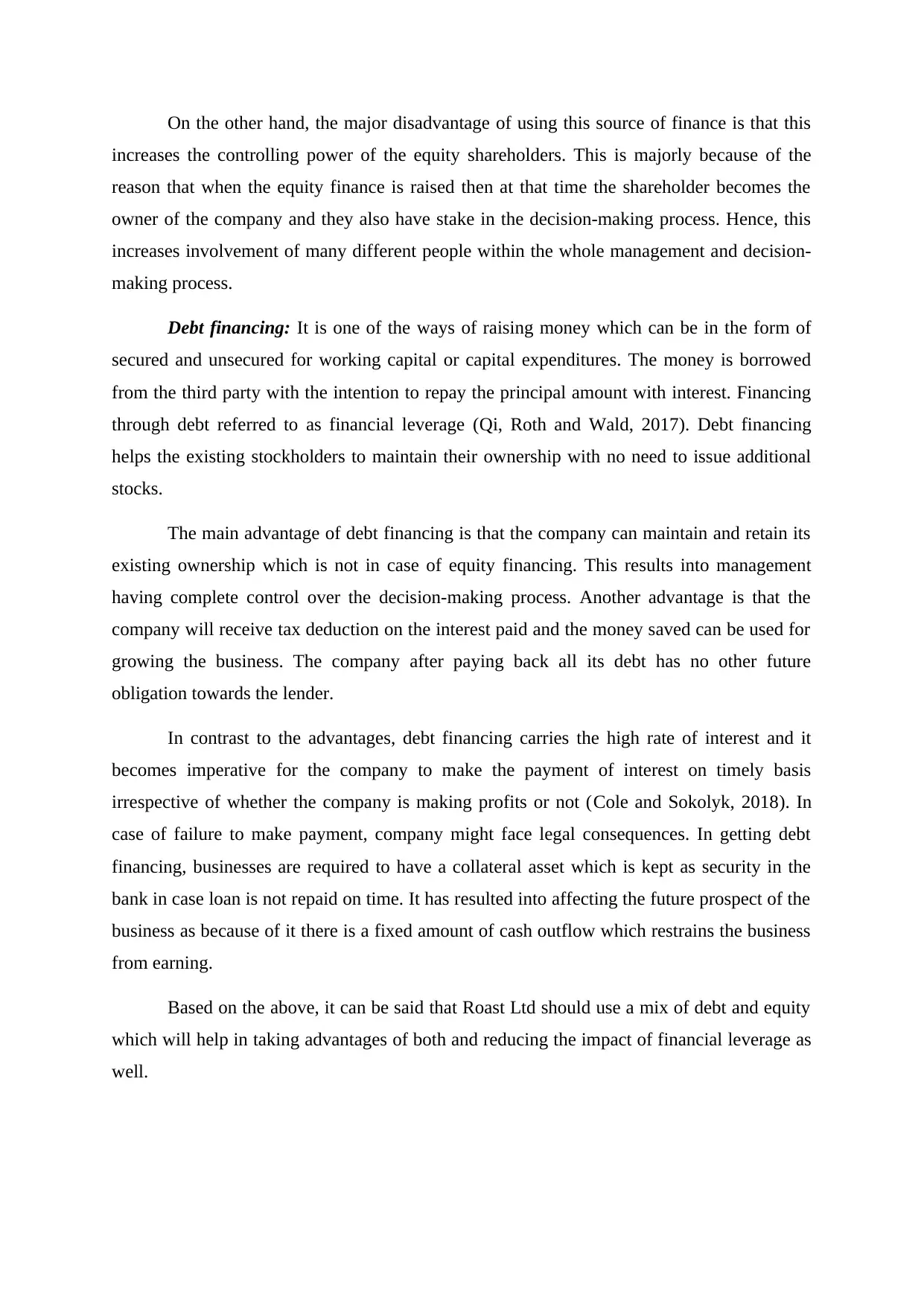
On the other hand, the major disadvantage of using this source of finance is that this
increases the controlling power of the equity shareholders. This is majorly because of the
reason that when the equity finance is raised then at that time the shareholder becomes the
owner of the company and they also have stake in the decision-making process. Hence, this
increases involvement of many different people within the whole management and decision-
making process.
Debt financing: It is one of the ways of raising money which can be in the form of
secured and unsecured for working capital or capital expenditures. The money is borrowed
from the third party with the intention to repay the principal amount with interest. Financing
through debt referred to as financial leverage (Qi, Roth and Wald, 2017). Debt financing
helps the existing stockholders to maintain their ownership with no need to issue additional
stocks.
The main advantage of debt financing is that the company can maintain and retain its
existing ownership which is not in case of equity financing. This results into management
having complete control over the decision-making process. Another advantage is that the
company will receive tax deduction on the interest paid and the money saved can be used for
growing the business. The company after paying back all its debt has no other future
obligation towards the lender.
In contrast to the advantages, debt financing carries the high rate of interest and it
becomes imperative for the company to make the payment of interest on timely basis
irrespective of whether the company is making profits or not (Cole and Sokolyk, 2018). In
case of failure to make payment, company might face legal consequences. In getting debt
financing, businesses are required to have a collateral asset which is kept as security in the
bank in case loan is not repaid on time. It has resulted into affecting the future prospect of the
business as because of it there is a fixed amount of cash outflow which restrains the business
from earning.
Based on the above, it can be said that Roast Ltd should use a mix of debt and equity
which will help in taking advantages of both and reducing the impact of financial leverage as
well.
increases the controlling power of the equity shareholders. This is majorly because of the
reason that when the equity finance is raised then at that time the shareholder becomes the
owner of the company and they also have stake in the decision-making process. Hence, this
increases involvement of many different people within the whole management and decision-
making process.
Debt financing: It is one of the ways of raising money which can be in the form of
secured and unsecured for working capital or capital expenditures. The money is borrowed
from the third party with the intention to repay the principal amount with interest. Financing
through debt referred to as financial leverage (Qi, Roth and Wald, 2017). Debt financing
helps the existing stockholders to maintain their ownership with no need to issue additional
stocks.
The main advantage of debt financing is that the company can maintain and retain its
existing ownership which is not in case of equity financing. This results into management
having complete control over the decision-making process. Another advantage is that the
company will receive tax deduction on the interest paid and the money saved can be used for
growing the business. The company after paying back all its debt has no other future
obligation towards the lender.
In contrast to the advantages, debt financing carries the high rate of interest and it
becomes imperative for the company to make the payment of interest on timely basis
irrespective of whether the company is making profits or not (Cole and Sokolyk, 2018). In
case of failure to make payment, company might face legal consequences. In getting debt
financing, businesses are required to have a collateral asset which is kept as security in the
bank in case loan is not repaid on time. It has resulted into affecting the future prospect of the
business as because of it there is a fixed amount of cash outflow which restrains the business
from earning.
Based on the above, it can be said that Roast Ltd should use a mix of debt and equity
which will help in taking advantages of both and reducing the impact of financial leverage as
well.
Paraphrase This Document
Need a fresh take? Get an instant paraphrase of this document with our AI Paraphraser
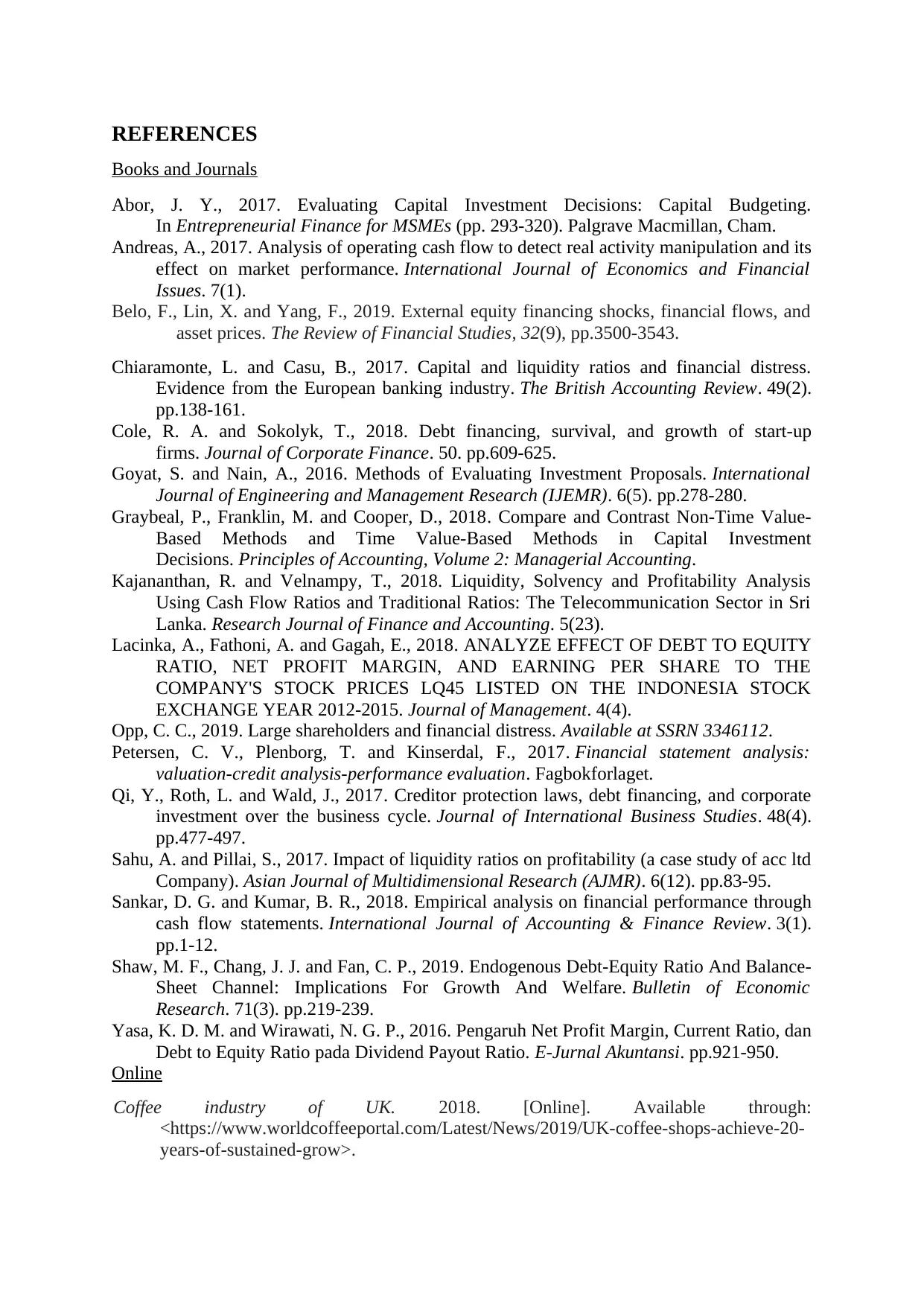
REFERENCES
Books and Journals
Abor, J. Y., 2017. Evaluating Capital Investment Decisions: Capital Budgeting.
In Entrepreneurial Finance for MSMEs (pp. 293-320). Palgrave Macmillan, Cham.
Andreas, A., 2017. Analysis of operating cash flow to detect real activity manipulation and its
effect on market performance. International Journal of Economics and Financial
Issues. 7(1).
Belo, F., Lin, X. and Yang, F., 2019. External equity financing shocks, financial flows, and
asset prices. The Review of Financial Studies, 32(9), pp.3500-3543.
Chiaramonte, L. and Casu, B., 2017. Capital and liquidity ratios and financial distress.
Evidence from the European banking industry. The British Accounting Review. 49(2).
pp.138-161.
Cole, R. A. and Sokolyk, T., 2018. Debt financing, survival, and growth of start-up
firms. Journal of Corporate Finance. 50. pp.609-625.
Goyat, S. and Nain, A., 2016. Methods of Evaluating Investment Proposals. International
Journal of Engineering and Management Research (IJEMR). 6(5). pp.278-280.
Graybeal, P., Franklin, M. and Cooper, D., 2018. Compare and Contrast Non-Time Value-
Based Methods and Time Value-Based Methods in Capital Investment
Decisions. Principles of Accounting, Volume 2: Managerial Accounting.
Kajananthan, R. and Velnampy, T., 2018. Liquidity, Solvency and Profitability Analysis
Using Cash Flow Ratios and Traditional Ratios: The Telecommunication Sector in Sri
Lanka. Research Journal of Finance and Accounting. 5(23).
Lacinka, A., Fathoni, A. and Gagah, E., 2018. ANALYZE EFFECT OF DEBT TO EQUITY
RATIO, NET PROFIT MARGIN, AND EARNING PER SHARE TO THE
COMPANY'S STOCK PRICES LQ45 LISTED ON THE INDONESIA STOCK
EXCHANGE YEAR 2012-2015. Journal of Management. 4(4).
Opp, C. C., 2019. Large shareholders and financial distress. Available at SSRN 3346112.
Petersen, C. V., Plenborg, T. and Kinserdal, F., 2017. Financial statement analysis:
valuation-credit analysis-performance evaluation. Fagbokforlaget.
Qi, Y., Roth, L. and Wald, J., 2017. Creditor protection laws, debt financing, and corporate
investment over the business cycle. Journal of International Business Studies. 48(4).
pp.477-497.
Sahu, A. and Pillai, S., 2017. Impact of liquidity ratios on profitability (a case study of acc ltd
Company). Asian Journal of Multidimensional Research (AJMR). 6(12). pp.83-95.
Sankar, D. G. and Kumar, B. R., 2018. Empirical analysis on financial performance through
cash flow statements. International Journal of Accounting & Finance Review. 3(1).
pp.1-12.
Shaw, M. F., Chang, J. J. and Fan, C. P., 2019. Endogenous Debt‐Equity Ratio And Balance‐
Sheet Channel: Implications For Growth And Welfare. Bulletin of Economic
Research. 71(3). pp.219-239.
Yasa, K. D. M. and Wirawati, N. G. P., 2016. Pengaruh Net Profit Margin, Current Ratio, dan
Debt to Equity Ratio pada Dividend Payout Ratio. E-Jurnal Akuntansi. pp.921-950.
Online
Coffee industry of UK. 2018. [Online]. Available through:
<https://www.worldcoffeeportal.com/Latest/News/2019/UK-coffee-shops-achieve-20-
years-of-sustained-grow>.
Books and Journals
Abor, J. Y., 2017. Evaluating Capital Investment Decisions: Capital Budgeting.
In Entrepreneurial Finance for MSMEs (pp. 293-320). Palgrave Macmillan, Cham.
Andreas, A., 2017. Analysis of operating cash flow to detect real activity manipulation and its
effect on market performance. International Journal of Economics and Financial
Issues. 7(1).
Belo, F., Lin, X. and Yang, F., 2019. External equity financing shocks, financial flows, and
asset prices. The Review of Financial Studies, 32(9), pp.3500-3543.
Chiaramonte, L. and Casu, B., 2017. Capital and liquidity ratios and financial distress.
Evidence from the European banking industry. The British Accounting Review. 49(2).
pp.138-161.
Cole, R. A. and Sokolyk, T., 2018. Debt financing, survival, and growth of start-up
firms. Journal of Corporate Finance. 50. pp.609-625.
Goyat, S. and Nain, A., 2016. Methods of Evaluating Investment Proposals. International
Journal of Engineering and Management Research (IJEMR). 6(5). pp.278-280.
Graybeal, P., Franklin, M. and Cooper, D., 2018. Compare and Contrast Non-Time Value-
Based Methods and Time Value-Based Methods in Capital Investment
Decisions. Principles of Accounting, Volume 2: Managerial Accounting.
Kajananthan, R. and Velnampy, T., 2018. Liquidity, Solvency and Profitability Analysis
Using Cash Flow Ratios and Traditional Ratios: The Telecommunication Sector in Sri
Lanka. Research Journal of Finance and Accounting. 5(23).
Lacinka, A., Fathoni, A. and Gagah, E., 2018. ANALYZE EFFECT OF DEBT TO EQUITY
RATIO, NET PROFIT MARGIN, AND EARNING PER SHARE TO THE
COMPANY'S STOCK PRICES LQ45 LISTED ON THE INDONESIA STOCK
EXCHANGE YEAR 2012-2015. Journal of Management. 4(4).
Opp, C. C., 2019. Large shareholders and financial distress. Available at SSRN 3346112.
Petersen, C. V., Plenborg, T. and Kinserdal, F., 2017. Financial statement analysis:
valuation-credit analysis-performance evaluation. Fagbokforlaget.
Qi, Y., Roth, L. and Wald, J., 2017. Creditor protection laws, debt financing, and corporate
investment over the business cycle. Journal of International Business Studies. 48(4).
pp.477-497.
Sahu, A. and Pillai, S., 2017. Impact of liquidity ratios on profitability (a case study of acc ltd
Company). Asian Journal of Multidimensional Research (AJMR). 6(12). pp.83-95.
Sankar, D. G. and Kumar, B. R., 2018. Empirical analysis on financial performance through
cash flow statements. International Journal of Accounting & Finance Review. 3(1).
pp.1-12.
Shaw, M. F., Chang, J. J. and Fan, C. P., 2019. Endogenous Debt‐Equity Ratio And Balance‐
Sheet Channel: Implications For Growth And Welfare. Bulletin of Economic
Research. 71(3). pp.219-239.
Yasa, K. D. M. and Wirawati, N. G. P., 2016. Pengaruh Net Profit Margin, Current Ratio, dan
Debt to Equity Ratio pada Dividend Payout Ratio. E-Jurnal Akuntansi. pp.921-950.
Online
Coffee industry of UK. 2018. [Online]. Available through:
<https://www.worldcoffeeportal.com/Latest/News/2019/UK-coffee-shops-achieve-20-
years-of-sustained-grow>.
1 out of 14
Related Documents
Your All-in-One AI-Powered Toolkit for Academic Success.
+13062052269
info@desklib.com
Available 24*7 on WhatsApp / Email
![[object Object]](/_next/static/media/star-bottom.7253800d.svg)
Unlock your academic potential
© 2024 | Zucol Services PVT LTD | All rights reserved.





